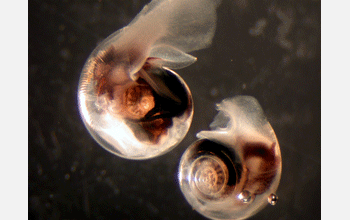Multimedia Gallery
Antarctic Pteropod Limacina helicina (Image 2)
Antarctic Pteropod Limacina helicina (Image 2)
The Antarctic pteropod Limacina helicina Antarctica, seen here under a microscope, is about the size of a pepper grain and a notable component of the zooplankton around McMurdo Station, Antarctica. Researchers are worried that an increase of atmospheric CO2 may threaten this vulnerable animal's chances of survival.
More about this Image
L. helicina is the focus of an investigation led by Gretchen Hofmann, an associate professor at the University of California, Santa Barbara. Hofmann investigates the effects of environmental stress, such as ocean warming and acidification, on marine animals, and has led several field expeditions to Antarctica.
With support from a National Science Foundation Small Grant for Exploratory Research (SGER) (SGER 08-08947), Hofmann is working in collaboration with Victoria Fabry of Cal State San Marcos to develop genomic resources for L. helicina. The primary goal of the project is to collect samples of pteropod tissues that will be used to obtain a DNA sequence from coding genes in the pteropod genome. Using these samples, scientists will use "454 sequencing" (a system for ultra-high-throughput DNA sequencing run by a commercial company) to generate a DNA sequence for L. helicina, that will be available to facilitate gene expression profiling in pteropods.
L. helicina--a shelled (thecosomatous) mollusk that is planktonic and routinely found in plankton--was chosen as the subject of this research due to its ecological importance and the high likelihood that shell formation and physiology will be detrimentally impacted by ocean acidification. Cosomatous pteropods are an important food source for a variety of Antarctic organisms and are so abundant in some regions of the Southern Ocean, that there can be thousands of individuals per cubic meter. In McMurdo Sound (where krill are absent), L. helicina may constitute more than 20 percent of the zooplankton biomass. Because it is such an important part of the Antarctic food web, pteropods have been targeted as a critical and urgent study species. This urgency is also due to the fact that since pteropod mollusk shells are made of aragonite, a form of CaCO3 that is very soluble, the organisms will be highly impacted by elevated CO2 and the resulting under-saturation of carbonate ion in seawater. Additionally, within the next 50 to 100 years, surface waters of the Southern Ocean will be among the first surface ocean waters to become undersaturated with respect to aragonite due to ocean acidification. Taken together, these observations underscore the need to understand the response of pteropods like L. helicina as a critical step in predicting the impact of ocean acidification on the Antarctic marine ecosystem. (Date of Image: March 2002) [See Related Image.]
Credit: Gretchen Hofmann, UC Santa Barbara
Images and other media in the National Science Foundation Multimedia Gallery are available for use in print and electronic material by NSF employees, members of the media, university staff, teachers and the general public. All media in the gallery are intended for personal, educational and nonprofit/non-commercial use only.
Images credited to the National Science Foundation, a federal agency, are in the public domain. The images were created by employees of the United States Government as part of their official duties or prepared by contractors as "works for hire" for NSF. You may freely use NSF-credited images and, at your discretion, credit NSF with a "Courtesy: National Science Foundation" notation.
Additional information about general usage can be found in Conditions.
Also Available:
Download the high-resolution TIF version of the image. (9.9 MB)
Use your mouse to right-click (Mac users may need to Ctrl-click) the link above and choose the option that will save the file or target to your computer.



